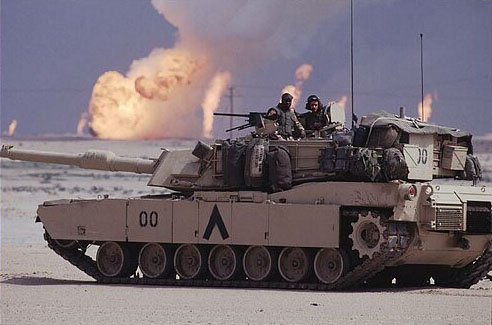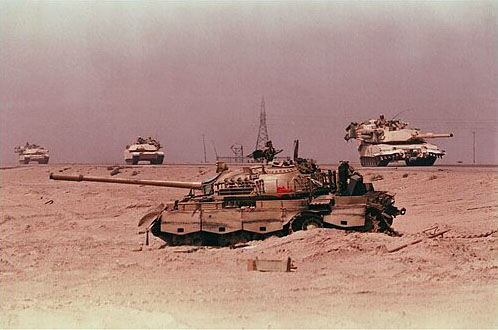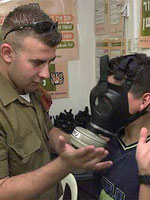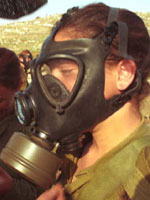|
|

Desert Storm |
|
|
 A U.S. Army M1A1 Abrams main battle tank in the burning oil fields of Kuwait, Operation Desert Storm, 1991.
A U.S. Army M1A1 Abrams main battle tank in the burning oil fields of Kuwait, Operation Desert Storm, 1991. |
| |
 US M1A1s on the road in Iraq pass a destroyed Iraqi tank after the liberation of Kuwait, Operation Desert Storm, 1991.
US M1A1s on the road in Iraq pass a destroyed Iraqi tank after the liberation of Kuwait, Operation Desert Storm, 1991. |
| |
|
|
| As early as 1939, Iraq deployed forces in order to conquer Kuwait, which was then still a British colony. At the last minute, the king of Iraq died in a car accident and the invasion was cancelled. In 1961, when Kuwait was granted independence, Iraq again prepared forces to invade Kuwait and retreated only when Britain redeployed its forces to the area.
On 2 August 1990, Iraq invaded Kuwait. This action was roundly condemned by the United States, which soon after declared that it could not allow this situation to continue. The invasion escalated tension in the Persian Gulf and the led to expansion of American forces stationed in Saudi Arabia.
The integration of armies from different countries, the giving of an ultimatum to Iraq, and when this ceased – prolonged air strikes on Iraqi targets and finally actual ground military action that resulted in the freeing of Kuwait, and the imposition of various sanctions on Iraq. |
| |
Sides in the Conflict |
| |
| The Iraq-Kuwait border was the focus of tension for many years. When Kuwait received her independence from Britain in 1961, Iraq threatened to invade the country. As mentioned, according to Baghdad, Kuwait has been considered a southern province of Iraq since Ottoman times. Iraq took steps in the past to realize this claim through planned invasions of the area. (See Iraq – General Background)
Kuwait of 1990, headed by Amir of the Al-Sabah family, was an easy and attractive target for Iraq. The country was without any significant military strength that could protect her, and the oil fields in her territory were a valuable economic commodity. Upon the invasion of Kuwait, Saddam was in de facto control of 20% of the world's oil reserves, threatening an additional 20% of those reserves in Saudi Arabia.
Also, Kuwait harmed Iraq by lowering the oil prices, thereby reducing Iraq's own oil revenue profits. Iraq borrowed substantial amounts of money from Kuwait in order to fund its long conflict with Iran. Much to Saddam Hussein's chagrin, Kuwait insisted on repayment of this debt.
Another factor speeding an American led response to the Iraqi invasion was the highly touted reports of massacres and war crimes that the Iraqis committed against the Kuwaiti people. These publications struck a chord in American public opinion, and fueled fears that these deeds might continue and even intensify should Iraq invade Saudi Arabia. In contrast, Americans opposition to military action included the fear of heavy casualties and claims that the only pretext for the U.S. response concern for oil supplies. |
| |
“Desert Shield” |
| |
| After occupying Kuwait, Iraq deployed Republican Army units to the Kuwait-Saudi Arabia border. By 6 August, when some eleven divisions were stationed along that border, intelligence pundits assessed that at that time Iraq was capable of successfully invading Saudi Arabia.
The Saudi King Fahd considered these moves a serious threat and asked for assistance from the United States. President George Bush ordered the deployment of the U.S. military to Saudi Arabia and the Persian Gulf in a operation called “Desert Shield”. The aim of the operation was ostensibly the defence of Saudi Arabia.
At the same time, the U.S. began intense diplomatic activity to pull together an international coalition to counter Iraqi aggression. The coalition finally assembled included a number of NATO countries, including Britain, France and Canada, as well as a number of neighboring Arab countries and even a few former Warsaw Pact members. Supporting the coalition was the U.N. resolution from 29 November that approved the use of “all necessary means” to remove Iraq from Kuwait and set an ultimatum for Iraqi withdrawal by 15 January. |
| |
“Desert Storm” – The Air Strike |
| |
| After the U. N. ultimatum expired on 15 January, many of the coalition forces joined the attack on Iraq (a notable exception were the Egyptians and Syrians). As of the morning of 17 January, coalition forces commenced a massive air strike on Iraqi targets. That day, for the first time, Iraq launched a SCUD missile towards Israel.
Over the course of five and a half weeks, coalition forces carried out some 100,000 sorties on Iraq that badly damaged Iraqi forces. Despite the use of guided cruise missiles and similar “smart” weaponry, attempts to strike the Iraqi command and control infrastructure, communication centers, power stations, bridges and other targets also resulted in the harm of civilians and the disruption of civilian life.
In an attempt to disrupt the coalition, Iraq fired SCUD missiles towards Saudi Arabia and Israel. By this tactic, Iraq tried to convince Arab countries that were members of the coalition fighting on Israel's side. The coalition, however, remained steadfast. Israel abetted this steadfastness by refraining from responding to the missile attacks.
A month after the air campaign began, Iraq initiated diplomatic contacts with the Soviet Union and commenced preliminary negotiations concerning its withdrawal from Kuwait. The coalition, however, remained united in its demand for an unconditional withdrawal from Kuwait. |
| |
Ground Operations |
| |
| On 24 February, American forces began ground operations. The attack was concentrated in southwest Iraq and coalition forces advanced north and west, surrounding Kuwait and the Iraqi forces inside, allowing coalition forces (mainly from western states) to occupy Kuwait City. |
| |
Ground Attack |
| |
| The coalition forces opened a ground offensive on 24 February. The attack began in southwest Iraq, where the ground forces proceeded north and west and surrounded Iraqi forces, allowing the coalition forces (primarily from Arab states) to liberate Kuwait City. A number of Iraqi forces initially put up resistance.
However, the coalition forces advanced more quickly than anticipated and thousands of Iraqi soldiers surrendered without a struggle, while others deserted. Iraq concentrated most of its efforts on withdrawing its elite units and destroying the Kuwaiti infrastructure, including the burning of oil fields. This latter action resulted in widespread ecological damage.
Two days after the opening of the ground offensive, Iraq announced its withdrawal from Kuwait.
On 28 February, after the Iraqi resistance crumbled and Kuwait was freed from Iraqi control, coalition forces announced a cease-fire.
On 2 March, the United Nations Security Council issued a decision announcing the cease fire terms as accepted by Iraq. |
| |
| |
Israel And The Gulf War |
| |

A battle in Israel's skies: The Patriot vs. the SCUD.
|
| |
 
|
| |
| |
| When Iraq invaded Kuwait in August 1990, it threatened to attack Israel by various means, including non-conventional weapons. It was Baghdad's declared goal to destroy much of the State of Israel. This represented the first time in Israel's history that the country faced an existential threat by non-conventional weapons. At the same time, under U.S. leadership, a strong coalition was created against Iraq.
The challenges facing Israel and the Israel Defense Forces (IDF) resulted from the following potential scenarios:
Withdrawal of the Iraqi army from Kuwait and movement toward Jordan with the intention
to attack Israel. Such a move would neutralize the coalition that was established to
fight Iraq, particularly in regard to the participating Arab states (i.e. Saudi Arabia,
Egypt and Syria).
Conventional and non-conventional missile attacks upon Israel
Air attack upon Israel
Terrorism
Artillery attacks on civilian targets
Attacks on plants and warehouses storing dangerous materials
For the first time in Israel's history, the IDF was forbidden to initiate defensive action, as this was a condition of Saudi Arabia in joining the coalition. (Saudi Arabia served as the coalition's base of operations). In addition, the fact that Jordan is situated between Israel and Iraqi targets constituted an additional obstacle to Israel's involvement, as there was concern not to involve Jordan in the war. The international coalition required six months in order to organize its forces. Israel took advantage of this period to reinforce its preparations for the coming conflict.
The IDF prepared itself for a possible confrontation with an Iraqi expeditionary force likely to attack from Jordan, as well as preparations to attack Iraqi targets. At the same time, Israel prepared its civilian population for conventional and chemical attacks. The following actions were taken:
Distribution of gas masks
Upgrading and training of civil defense units
Preparation of the entire population, particularly schools and the industrial sector
Placing emphasis on the importance of sealed rooms to the civilian population as
defense against chemical weapons attacks.
Examination of the warning systems
Cooperation between the police, fire department, Magen David Adom and hospitals
Linkage of the early warning system against incoming missiles through U.S. satellites
On the night of 17-18 January 1991, the coalition forces attacked Iraq. In response, Iraq fired SCUD missiles at targets in Israel. In a period of over a month, 39 SCUDs were fired at Israel in 19 volleys. The missiles primarily hit the metropolitan Tel Aviv and the Haifa areas, though missiles also fell in the areas of western Samaria and Dimona.
These attacks caused the direct death of two civilians, as well as the following casualties:
Four individuals suffered heart attacks
Seven deaths due to incorrect use of gas masks
259 wounded
225 faulty applications of antibiotics
Damage to property included 332 homes, 6,142 apartments, 23 public buildings, 200
stores and 50 automobiles.
During this war, Israel's home front was the focal point for activities, and for the first time, the IDF focused its primary efforts on the protection of civilians and cooperation between government offices and emergency services. Regular IDF forces were assigned to two areas, central Israel and Haifa, to assist with search and identification efforts. In addition, divisional commands supported home front regional commands. The civilian rescue services requested assistance to identify areas hit by incoming missiles. Patriot missiles (deployed in Israel but manned by U.S. and later Dutch forces) proved to have limited capability in confronting the incoming missiles, and in some cases, caused additional damage. It is important to note that Patriot missiles were not designed to destroy incoming missiles, but rather to confront attack aircraft.
Following the conclusion of the Gulf War, the IDF was forced to change its approaching regarding Israel's defense. Over the years, the IDF prepared itself for war with its neighboring states and prepared its weapons systems accordingly. These systems were not prepared for confrontation with states that do not border Israel. Consequently, the IDF took a number of steps to meet the new strategic challenges:
Intelligence. Obtaining intelligence material from satellites due to the geographic
distances.
Acquisitions of long range F-15I fighter jets and Apache and Blackhawk helicopters to
attack peripheral states.
Development of ballistic missile systems, via the Arrow anti-missile missile project.
Establishment of the Home Front Command to defend Israel's civilians |
 |
